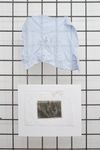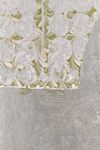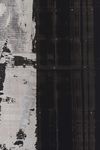Christian Andersen, Frederiksholms Kanal 28A, 1220 Copenhagen K, +45 2537 4101, info@christianandersen.net
Images
Press release
For Art Basel Paris 2025, Fanta-MLN and Christian Andersen presents a joint project with works by Patricia L. Boyd, Jason Hirata, Benjamin Hirte, and Lorenza Longhi, which reflect on the infrastructures of our contemporaneity, conceived as the physical networks and immaterial relations which define our present. By creating gaps and fractures, the works strive to grasp these conditions and suggest possible torsions within them.
Patricia L. Boyd is interested in addressing the physical, economic and institutional infrastructures within which the work is made and exhibited. Her works are characterised by a display of the negative through the use of inversion, elision and removal. The work presented is the latest addition to her Wall Pieces series, in which recycled cooking grease from restaurant kitchens is used to cast negatives of details of office furniture—in this case two elements from a Herman Miller Aeron Chair—from a Bay Area tech company’s liquidation auction. In their first iteration the casts are embedded in the wall, and a portion of it remains attached to them once they are extracted, retaining traces of the negotiations between the artist and the institution.
Patricia L. Boyd’s work Untitled present the world in macro and microcosm. Drax power station in North Yorkshire is the largest power station in Britain and produces 6% of the country’s electricity. Although burning biomass and thus classified as producing ‘renewable energy’ it has recently been revealed to be exploiting wood sourced from ancient, un-renevable forestry in British Colombia, Canada. Untitled includes a photogravure satellite image of some land deforested to feed Drax’s twelve cooling towers. There is an element of self-reflexion in the image in that they are conceived knowing that the printing plate and its ink are products of heavy industry (being respectively steel and carbon-based). The print both refer to and are the result of a reproductive act.
For Art Basel Paris 2025 the gallery presents a new version of a stone sculpture from Benjamin Hirte’s recent solo show at the Kornhäuschen in Germany. The original work was shown in front of the buildings colonnade: a fragment of an oversized anatomical heart and it’s vascular structure, carved from local sandstone – the same material as the building itself and the historical town center. Cultural history and the construction of public and private space are recurring subjects in the artist’s research, which challenge the coded nature of reality and the power dynamics embodied in our built environments.
Heteronomy, dependency and contingency are constitutive elements for Jason Hirata, whose practice investigates the relations and structures underlying artistic production. Smell the Wind, 2025 is a new addition to a series of works in which shelving units are flattened until they act like images to the eye, taking on a dimensionality akin to the shadows found in ruins. The raw material of the work is both the physical object and the element of chance that defines its shape via hammering, but also the social material available to him, as the piece is physically produced by the gallerists. This gesture belongs to a series of attempts by the artist to de-emphasize himself as the sole producer of his works, instead inscribing his authorship through others.
Lorenza Longhi explores the infrastructures through which desire is constructed and displayed in our consumerist society, tracing the remnants of ostentation both materially and conceptually. Using mimicry and amateurishness, the artist disrupts standardization, embracing inefficiency as a form of resistance. The dyptich Untitled, 2025 continues her painting approach that hacks the silk-screening technique to deadstock fabrics and Tyvek.
















